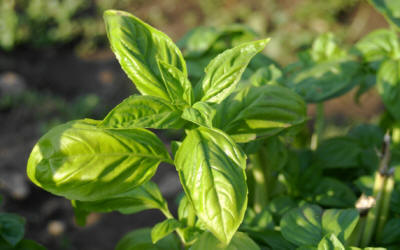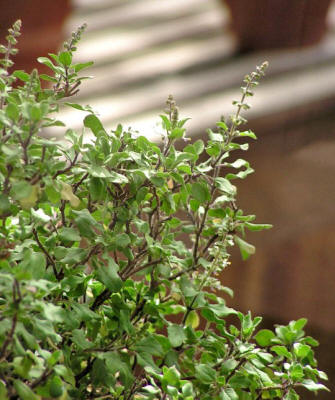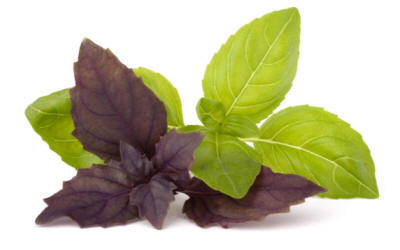|
from NaturalSociety Website
All herbs have a purpose - whether it's culinary or medicinal - but, it's a particularly good sign when an herb is revered as the “queen of herbs” and is held as a holy plant worthy of worship.
This plant, holy basil (tulsi), not only has medicinal benefits, but is also said to have spiritual benefits. What's more, holy basil benefits can be experienced in an exciting way, as the herb can be grown in your home or on your patio - making it a great addition to your healing herb garden.
Holy basil, or tulsi (Ocimum tenuiflorum) is a member of the mint family. It's closely related to the sweet basil you add to Italian dishes and pesto, but the flavors are quite different. This plant is sometimes referred to as pepper basil as it's clove-flavor is spicier than it's sweet counterpart.
The shrub can grow to about 30 to 60 cm high, has hairy stems and green (sometimes purple-tinged) small leaves.
When allowed to flower, the blossoms are violet. It's native to Eastern tropical regions and is especially widely known in India and Hindu countries where it is revered as a holy plant.
History and Spiritual Significance
In Hinduism, holy basil is worshiped as the incarnation of Lakshimi, the wife of Vishnu and one of that religion's most important deities.
It is called “The Incomparable One” and “Mother Medicine of Nature” among other things, and can be seen growing outside of Hindu temples.
Not only found in temples, you will see tulsi being cultivated outside of most Indian homes and in courtyards. In worship, it will be placed on an altar and held in reverence during meditation and prayer.
Though the herb has likely been growing in India the longest (an estimated 3,000 years), it was also prized by healers of ancient Greece and Rome and continues to be prized throughout the world as a plant that can heal the body, mind, and spirit.
But all potential spiritual benefits aside, the herb undoubtedly brings numerous health benefits to the table.
Tulsi is an erect, much branched subshrub, 30-60 cm tall with hairy stems and simple, opposite, green leaves that are strongly scented.
Some Holy Basil Benefits
In Ayurvedic medicine, holy basil has been used for thousands of years. However, it is just in recent decades (and especially the past few years) begun gaining popularity in the West.
The plant is said to be an adaptogen.
Adaptogens essentially adapt to serve the body where it needs them most. Typically, adaptogens are characterized as stress-busters, and this is where we will find the majority of research on tulsi.
While all scientific research on the plant has been done on lab animals and not reproduced in humans, case after case of anecdotal evidence and thousands of years of use can't be wrong.
Holy basil has numerous beneficial properties including:
These properties alone can account for many potential benefits including increased sense of well-being, increased immune function, and disease prevention.
Known benefits of holy basil include:
Both as a general health tonic and as a treatment for specific maladies, tulsi has been the go-to herb for millennia. Experience holy basil benefits today - by growing your own!
How to Grow Holy Basil
Tulsi is an excellent addition to any herb garden and can do well in either pots or in the ground.
It prefers warm soil, so don't plant seeds until after the last frost of the season and when the average daily temperature is 65 to 70 Fahrenheit. Alternately, you can start with a small plant and transplant it to the garden or pot to have a head start.
The holy basil plant prefers sunlight, so don't place it in a shady spot. A little afternoon shade would be okay, but full sun is best. Be cautious that it gets plenty of water, as drying out in the hot summer sun could mean certain death.
As it grows it will develop flowers. To encourage a larger, bushier plant, you can pinch off these blossoms. However, most sources say that letting the plant flower won't affect its healing potency much.
A note on harvesting: The flowers of your tulsi plant will bring plenty of bees to the garden, so if you want to harvest without risking a sting, head out to your garden first thing in the morning. Clip those parts higher than 5 inches and without flowers for the best leaves. Careful not to harvest more than you need as over-harvesting can harm a not-quite-established plant.
Using Holy Basil
Most practitioners will use holy basil in a tea, and this is the easiest way to reap holy basil benefits.
Simply cover 2 teaspoons of fresh tulsi leaves with 8 ounces of boiling water, then cover and let steep for about 5 minutes before straining the leaves off and drinking.
Alternately, there are many commercial holy basil products.
While growing your own is the very best (and not that difficult), it's not for everyone. If you don't have a green thumb and are tempted to opt for those already-prepared versions, make sure you are looking for high quality and organic products.
Sources
from NaturalSociety Website
A favorite herb and spice found in Italian dishes, Thai dishes, and some middle eastern dishes, sweet basil (Ocimum basilicum) is one of several varieties of basil known not only for its ability to add flavor, but medicinal aspects as well. In these regions, the basil plant has not only been used in cooking, but also in healing for centuries.
The plant is lush green with smooth rounded-edges and pointed-tip leaves. The leaves resemble peppermint leaves, as the two plants are closely related.
Sweet basil is the most common form of garden basil and can be found dried in the spice aisle, fresh in the produce aisle, or still in the dirt of many gardeners fortunate enough to cultivate it.
A Sweet Basil History
Sweet basil is originally from India and is also native to tropical regions of Asia, where it has been grown for more than 5,000 years.
The name is derived from the Greek word basilikohn which means “royal” - a fitting considering how prized this herb was in many cultures.
In Egypt, Greece, and India it was placed with the deceased to ensure a speedy travel to the afterlife. In India it is seen as a symbol of hospitality and is used prominently in Ayurvedic medicine.
On the flip side, some cultures considered the fragrant herb an evil plant, with one historic French physician believing that smelling too much of the herb would cause scorpions to breed in the brain.
(Don't worry, that won't happen).
Health Benefits of Sweet Basil
Sweet basil, like most herbs, is loaded with health benefits. In addition to being a rich source of vitamin K, beta carotene, and iron, the plant is known to harness anti-bacterial, anti-inflammatory, and antioxidant properties.
The majority of the great benefits of basil can be attributed to its volatile oils and flavonoids - powerful, plant-based antioxidants that reduce inflammation, help fight aging, and promote healthy arteries
In basil essential oil, the volatile oils within the plant have been shown to have incredible antibacterial properties.
Studies have confirmed the ability of these oils to restrict the growth of bacterial like,
...among others.
A study published in a 2004 issue of Food Microbiology demonstrated that basil oils can even stop the growth of antibiotic-resistant bacteria.
Scientists searching for natural, toxin-free food preservatives discovered that washing produce in a solution of as little as 1% basil essential oil decreased Shigella contamination below levels at which it could be detected.
They've suggested that including basil in your salad could provide similar safeguards.
Two flavonoids within sweet basil have shown particular promise in fighting cell damage from radiation and free radicals. Orientin and vicenin are antioxidants that work to protect the cells.
But the benefits of sweet basil don't stop there. Basil also:
In herbal medicine, basil can be taken for:
Growing Sweet Basil
Basil is a little more finicky than other plants in your herb garden, like thyme and mint. It prefers warm weather, so you won't want to plant it until after the last frost of the season. The plan also does well both in the ground or in pots.
There are several varieties. While some can grow to be as tall as 6 feet, most gardeners find their sweet basil to rest under 3 feet - if that. If you want to ensure a smaller basil plant, simply keep it in a pot, which will restrict root growth.
Sweet basil can be started from seed (you don't need to buy a small plant from the garden center).
Place your seeds about ¼ inch deep in the ground and about 10-12 inches apart from each separate planting. Make sure the spot you have chosen will get full sun as basil wants it bright and warm. Also, keep it well hydrated with adequate amounts of water.
In order to encourage a healthy plant with a lot of foliage, develop a habit to pinch off the tops of the growing stalks; this will encourage new growth and will also prevent flowering (known as “going to seed” in the gardening world). If your basil develops flowers, the flavor will lose some potency, so preventing flowers is a good idea.
However, if you do get flowers those are edible too!
Using Sweet Basil
The easiest way to use basil is to eat it. It's delicious and has a sort of spicy-sweet licorice flavor.
It tastes amazing in salads and especially with a sun-ripened tomato. While sweet basil is most often included in cooked meals, you'll get the most benefits when you eat it raw, though combining it with other foods won't lessen its impact.
You can also add basil to a salad vinaigrette. Simply combine it with extra virgin olive oil, a bit of garlic, and some apple cider vinegar for a healing combination that can be splashed on salads or used on bread.
Finally, a basil infusion is a great elixir when you need the medicinal qualities to soothe a cough or treat cramping. Simply pour boiled water over a handful of fresh basil leaves and allow to steep for at least five minutes before straining and drinking.
To extend your fresh basil as long as possible without having to dry it (and lose some of the flavor) try freezing it. For cooking or use on salads, puree the basil in a food processor and add just enough extra virgin olive oil to make a paste. Press it flat and wrap in freezer paper or a plastic freezer bag if you must. Then, when you need it you can simply break off a chunk to use anytime of year.
Growing your own basil for medicine is a way to take your health and gardening skills in your own hands and to the next level.
Both as a preventative measure and a natural remedy for illness, sweet basil is an excellent addition to any budding herbalist's collection.
Sources
...Cancer Fighter, Neuropathy Healer, and
Anti-Microbial
Holy basil (Ocimum tenuiflorum), also known internationally as tulsi, is highly prized in the natural healing community both for its heady scent and for its healing properties.
In the Hindu religion, holy basil is a sacred plant which is used during meditation and is considered a staple in every home garden.
Among herbalists, holy basil is known as an adaptogen. This means the herb increases the body's resistance to a variety of environmental threats or stressors. Holy basil's antioxidant abilities makes the herb a favorite super-food. It has been medically proven to combat cancer and heal neuropathy caused by surgery.
Holy basil oil may be used as a skin
care treatment for acne.
Holy Basil is a medically proven antioxidant which fights against cancer
In a 2007 clinical study published in the Journal of Medicinal Food, scientists tested the effectiveness of holy basil (Ocimum sanctum) leaf extract in rats who exhibited oxidative stress, DMBA-induced cancer, and an enzyme imbalance.
DMBA is a powerful toxin which is commonly used to initiate cancer tumors in laboratory animals for cancer research purposes. Four different concentrations of holy basil leaf extract were fed to rats over a five day period, then were injected with DMBA. When cancer symptoms were positively identified, the scientists measured the ability of holy basil to combat cancer.
At a dosage of 300mg per kilogram of body weight, holy basil leaf extract significantly reduced the formation of cancerous micronuclei, enzymes which metabolize toxins in the body, and oxidation in both proteins and fats.
Antioxidant and healthy enzymatic activity was
increased.
The researchers severed the sciatic nerve in the rats' paws, then measured the resulting neuropathy. Ocimum sanctum (holy basil) extract was then administered for ten days following the surgeries.
The scientists observed that holy basil extract reduced the effects of nerve degeneration, helped to make nerve receptors more sensitive to stimuli, and aided in motor control after the surgery.
The herb also curbed a rise in TBARS, an
indicator of oxidative stress, and increased the amount of calcium
and glutothione in the body of the rats.
Holy basil oil may be useful in the treatment of acne
The International Journal of Cosmetic Science published a 2006 study performed in Thailand which evaluated the effectiveness of three different kinds of Thai basil oil in the treatment of acne.
Researchers wanted to study the anti-bacterial activity of oils made from sweet basil (Ocimum basilicum), holy basil (Ocimum sanctum), and hoary basil (Ocimum americanum). Hoary basil had no anti-microbial effects against acne at all in vitro. However, both sweet basil oil and holy basil oil did.
While sweet basil oil was found to be
more effective against acne than holy basil oil, both herbs were
found to be suitable for a skin care treatment of acne.
September 20, 2009
Basil was recently shown to reduce swelling and inflammation in arthritic patients by about 73 percent, which is on par with commonly used drugs for arthritis.
The researcher who presented the results
at The British Pharmacology Conference said they were going to begin
studying the properties of basil to determine the active compounds
which could be made into drugs. This is in contrast to just
encouraging people to eat more fresh, organic basil. Many people
however, see the logic in simply consuming more basil on a regular
basis, while forgoing toxic drugs.
And really, if taking a bit
more than the recommended amount of Tylenol is causing liver damage
and killing people, wouldn't you say that taking any is too much?
When it's done, toss in a medium-sized handful of fresh basil leaves (add parsley too, if you like) and stir. Then add sea salt to flavor, a little more coconut or olive oil, and squeeze in the juice of a lime.
It's simple, delicious, nutrient dense, and beats food from a
jar or can any day of the week.
|




